2003 FORD E-350 load capacity
[x] Cancel search: load capacityPage 125 of 232
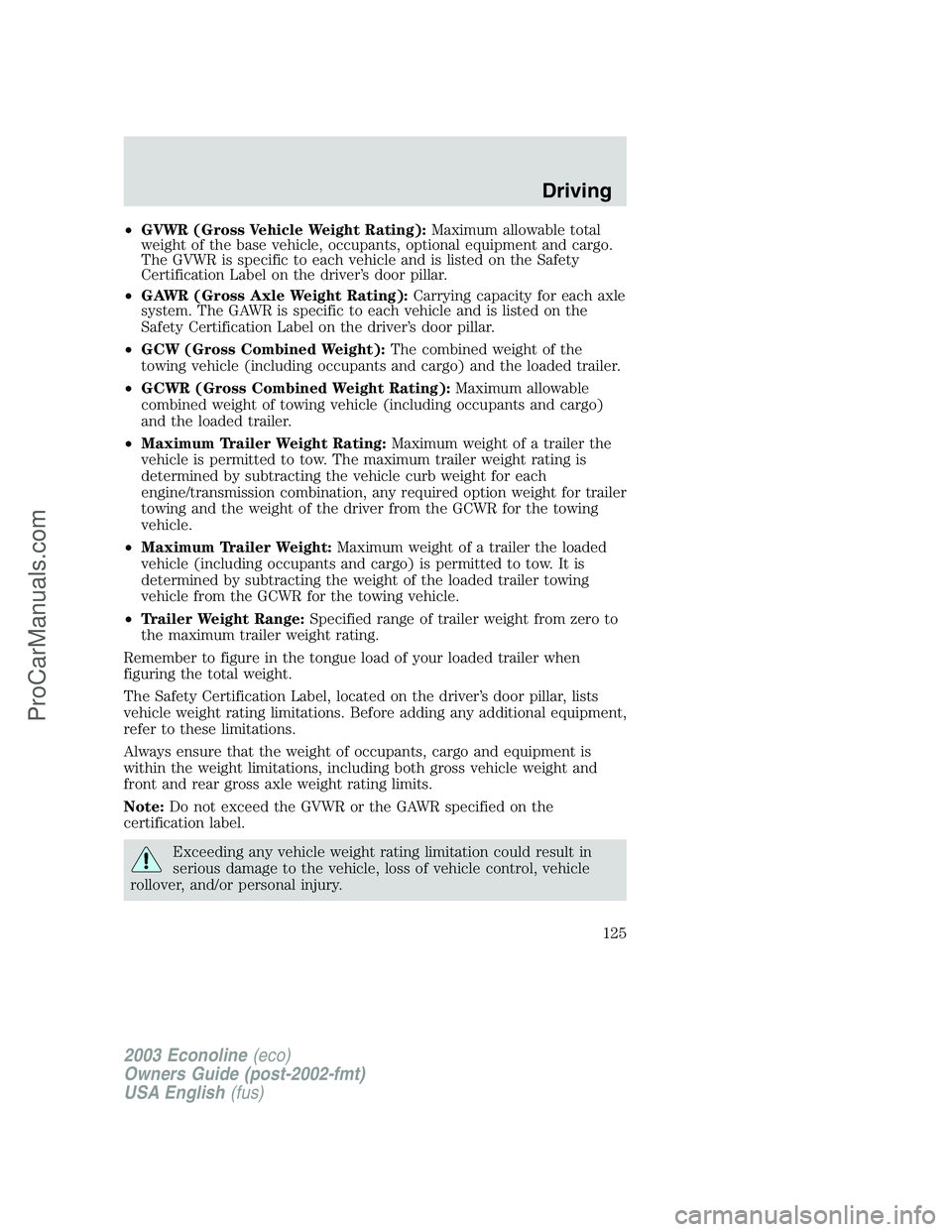
•GVWR (Gross Vehicle Weight Rating):Maximum allowable total
weight of the base vehicle, occupants, optional equipment and cargo.
The GVWR is specific to each vehicle and is listed on the Safety
Certification Label on the driver’s door pillar.
•GAWR (Gross Axle Weight Rating):Carrying capacity for each axle
system. The GAWR is specific to each vehicle and is listed on the
Safety Certification Label on the driver’s door pillar.
•GCW (Gross Combined Weight):The combined weight of the
towing vehicle (including occupants and cargo) and the loaded trailer.
•GCWR (Gross Combined Weight Rating):Maximum allowable
combined weight of towing vehicle (including occupants and cargo)
and the loaded trailer.
•Maximum Trailer Weight Rating:Maximum weight of a trailer the
vehicle is permitted to tow. The maximum trailer weight rating is
determined by subtracting the vehicle curb weight for each
engine/transmission combination, any required option weight for trailer
towing and the weight of the driver from the GCWR for the towing
vehicle.
•Maximum Trailer Weight:Maximum weight of a trailer the loaded
vehicle (including occupants and cargo) is permitted to tow. It is
determined by subtracting the weight of the loaded trailer towing
vehicle from the GCWR for the towing vehicle.
•Trailer Weight Range:Specified range of trailer weight from zero to
the maximum trailer weight rating.
Remember to figure in the tongue load of your loaded trailer when
figuring the total weight.
The Safety Certification Label, located on the driver’s door pillar, lists
vehicle weight rating limitations. Before adding any additional equipment,
refer to these limitations.
Always ensure that the weight of occupants, cargo and equipment is
within the weight limitations, including both gross vehicle weight and
front and rear gross axle weight rating limits.
Note:Do not exceed the GVWR or the GAWR specified on the
certification label.
Exceeding any vehicle weight rating limitation could result in
serious damage to the vehicle, loss of vehicle control, vehicle
rollover, and/or personal injury.
2003 Econoline(eco)
Owners Guide (post-2002-fmt)
USA English(fus)
Driving
125
ProCarManuals.com
Page 131 of 232
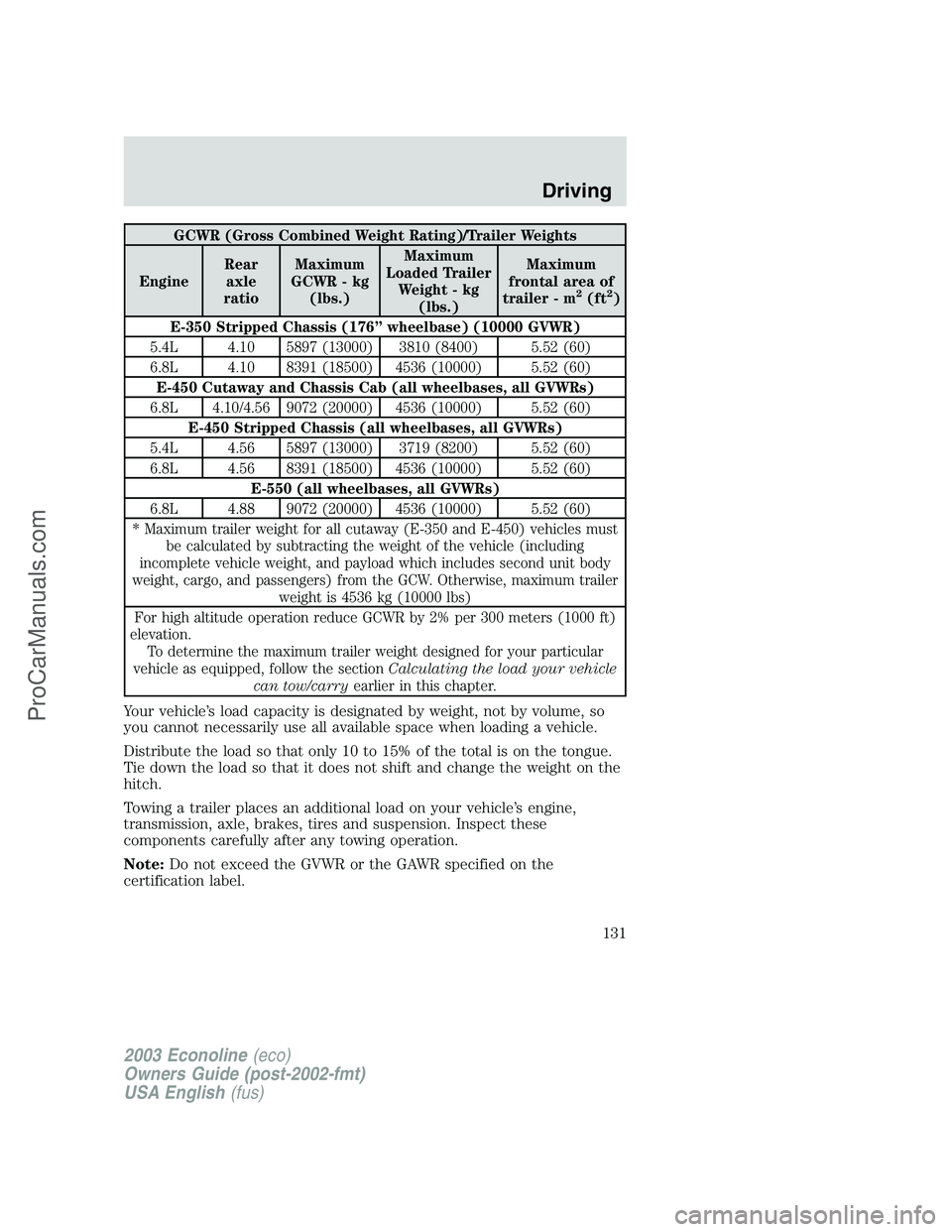
GCWR (Gross Combined Weight Rating)/Trailer Weights
EngineRear
axle
ratioMaximum
GCWR - kg
(lbs.)Maximum
Loaded Trailer
Weight - kg
(lbs.)Maximum
frontal area of
trailer - m
2(ft2)
E-350 Stripped Chassis (176”wheelbase) (10000 GVWR)
5.4L 4.10 5897 (13000) 3810 (8400) 5.52 (60)
6.8L 4.10 8391 (18500) 4536 (10000) 5.52 (60)
E-450 Cutaway and Chassis Cab (all wheelbases, all GVWRs)
6.8L 4.10/4.56 9072 (20000) 4536 (10000) 5.52 (60)
E-450 Stripped Chassis (all wheelbases, all GVWRs)
5.4L 4.56 5897 (13000) 3719 (8200) 5.52 (60)
6.8L 4.56 8391 (18500) 4536 (10000) 5.52 (60)
E-550 (all wheelbases, all GVWRs)
6.8L 4.88 9072 (20000) 4536 (10000) 5.52 (60)
* Maximum trailer weight for all cutaway (E-350 and E-450) vehicles must
be calculated by subtracting the weight of the vehicle (including
incomplete vehicle weight, and payload which includes second unit body
weight, cargo, and passengers) from the GCW. Otherwise, maximum trailer
weight is 4536 kg (10000 lbs)
For high altitude operation reduce GCWR by 2% per 300 meters (1000 ft)
elevation.
To determine the maximum trailer weight designed for your particular
vehicle as equipped, follow the sectionCalculating the load your vehicle
can tow/carryearlier in this chapter.
Your vehicle’s load capacity is designated by weight, not by volume, so
you cannot necessarily use all available space when loading a vehicle.
Distribute the load so that only 10 to 15% of the total is on the tongue.
Tie down the load so that it does not shift and change the weight on the
hitch.
Towing a trailer places an additional load on your vehicle’s engine,
transmission, axle, brakes, tires and suspension. Inspect these
components carefully after any towing operation.
Note:Do not exceed the GVWR or the GAWR specified on the
certification label.
2003 Econoline(eco)
Owners Guide (post-2002-fmt)
USA English(fus)
Driving
131
ProCarManuals.com
Page 133 of 232
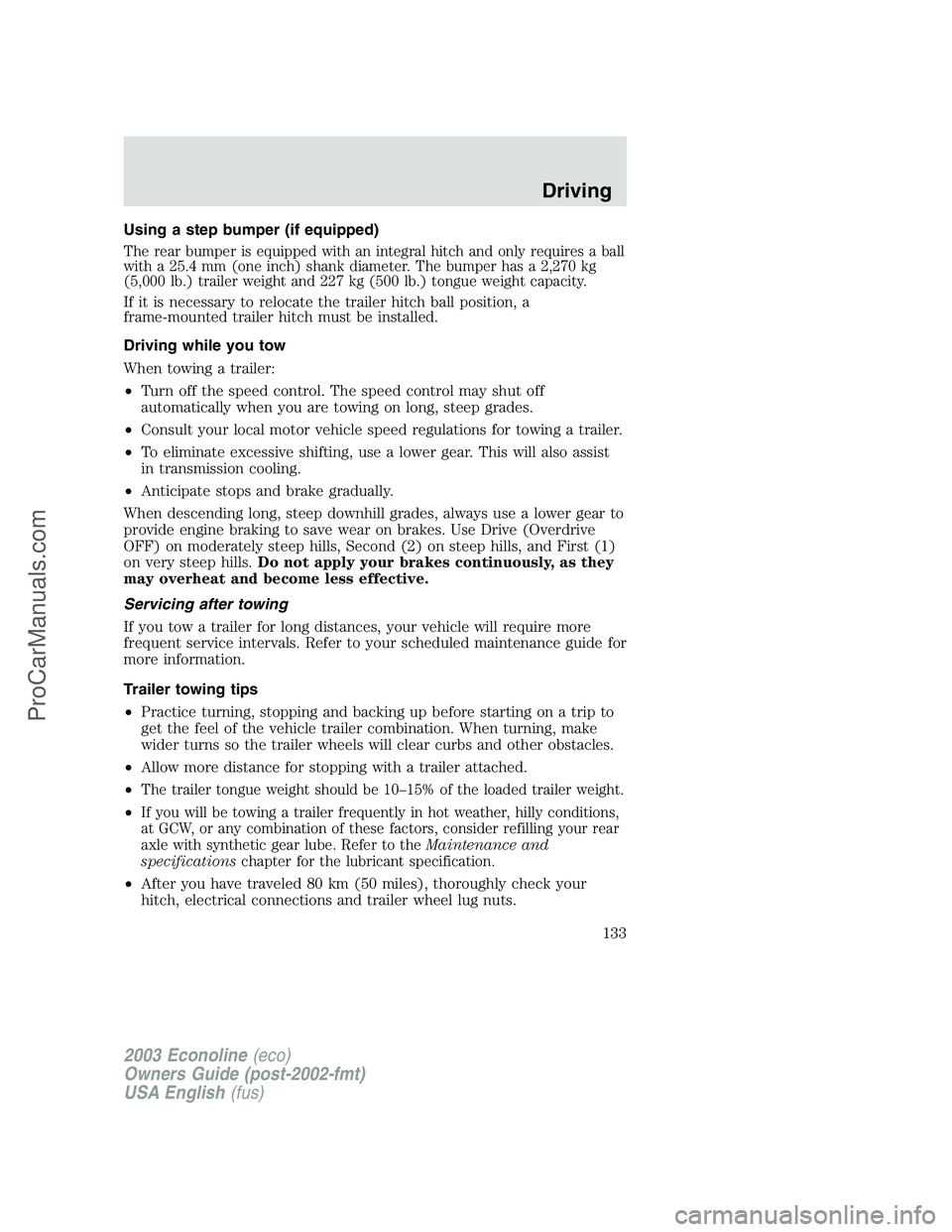
Using a step bumper (if equipped)
The rear bumper is equipped with an integral hitch and only requires a ball
with a 25.4 mm (one inch) shank diameter. The bumper has a 2,270 kg
(5,000 lb.) trailer weight and 227 kg (500 lb.) tongue weight capacity.
If it is necessary to relocate the trailer hitch ball position, a
frame-mounted trailer hitch must be installed.
Driving while you tow
When towing a trailer:
•Turn off the speed control. The speed control may shut off
automatically when you are towing on long, steep grades.
•Consult your local motor vehicle speed regulations for towing a trailer.
•To eliminate excessive shifting, use a lower gear. This will also assist
in transmission cooling.
•Anticipate stops and brake gradually.
When descending long, steep downhill grades, always use a lower gear to
provide engine braking to save wear on brakes. Use Drive (Overdrive
OFF) on moderately steep hills, Second (2) on steep hills, and First (1)
on very steep hills.Do not apply your brakes continuously, as they
may overheat and become less effective.
Servicing after towing
If you tow a trailer for long distances, your vehicle will require more
frequent service intervals. Refer to your scheduled maintenance guide for
more information.
Trailer towing tips
•Practice turning, stopping and backing up before starting on a trip to
get the feel of the vehicle trailer combination. When turning, make
wider turns so the trailer wheels will clear curbs and other obstacles.
•Allow more distance for stopping with a trailer attached.
•
The trailer tongue weight should be 10–15% of the loaded trailer weight.
•If you will be towing a trailer frequently in hot weather, hilly conditions,
at GCW, or any combination of these factors, consider refilling your rear
axle with synthetic gear lube. Refer to theMaintenance and
specificationschapter for the lubricant specification.
•After you have traveled 80 km (50 miles), thoroughly check your
hitch, electrical connections and trailer wheel lug nuts.
2003 Econoline(eco)
Owners Guide (post-2002-fmt)
USA English(fus)
Driving
133
ProCarManuals.com
Page 195 of 232
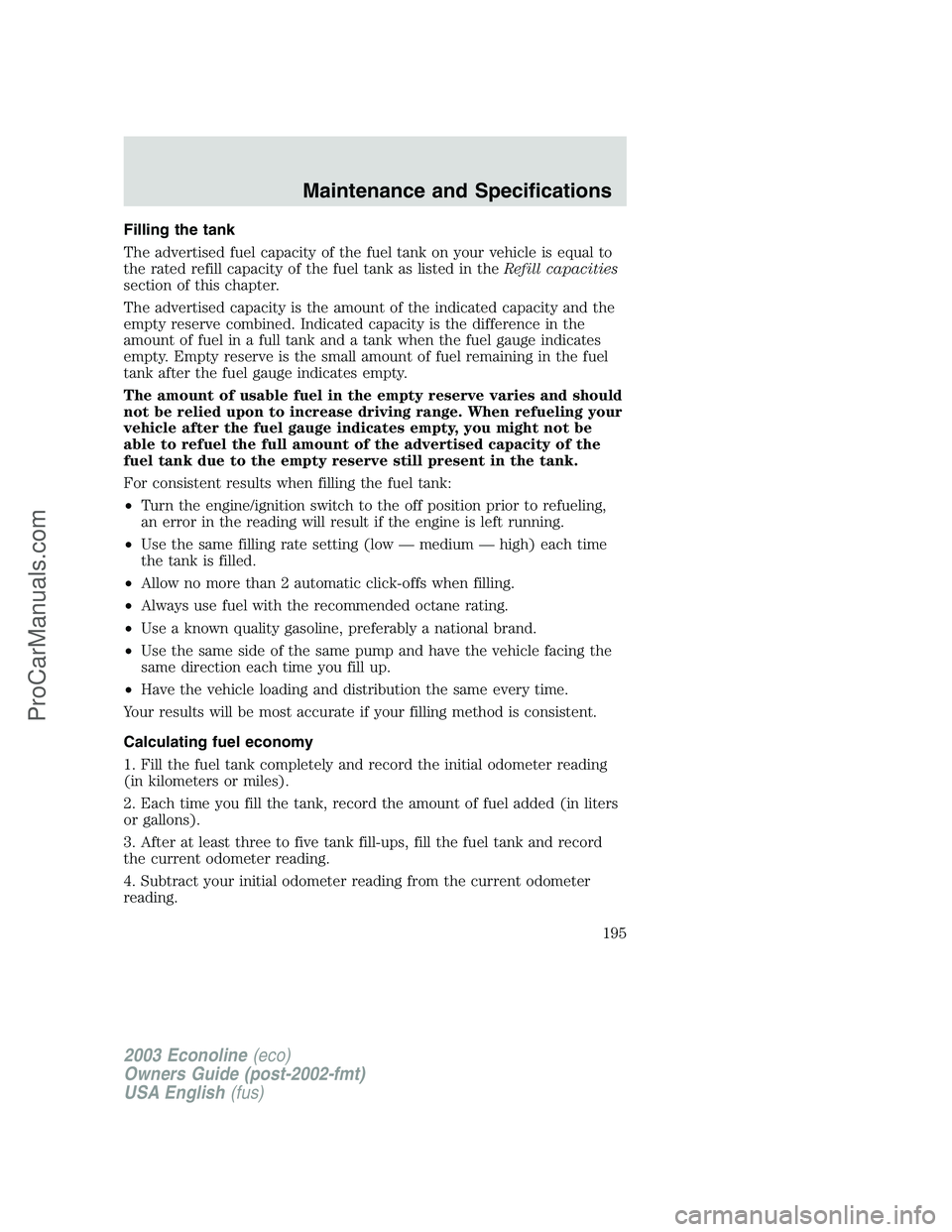
Filling the tank
The advertised fuel capacity of the fuel tank on your vehicle is equal to
the rated refill capacity of the fuel tank as listed in theRefill capacities
section of this chapter.
The advertised capacity is the amount of the indicated capacity and the
empty reserve combined. Indicated capacity is the difference in the
amount of fuel in a full tank and a tank when the fuel gauge indicates
empty. Empty reserve is the small amount of fuel remaining in the fuel
tank after the fuel gauge indicates empty.
The amount of usable fuel in the empty reserve varies and should
not be relied upon to increase driving range. When refueling your
vehicle after the fuel gauge indicates empty, you might not be
able to refuel the full amount of the advertised capacity of the
fuel tank due to the empty reserve still present in the tank.
For consistent results when filling the fuel tank:
•Turn the engine/ignition switch to the off position prior to refueling,
an error in the reading will result if the engine is left running.
•Use the same filling rate setting (low—medium—high) each time
the tank is filled.
•Allow no more than 2 automatic click-offs when filling.
•Always use fuel with the recommended octane rating.
•Use a known quality gasoline, preferably a national brand.
•Use the same side of the same pump and have the vehicle facing the
same direction each time you fill up.
•Have the vehicle loading and distribution the same every time.
Your results will be most accurate if your filling method is consistent.
Calculating fuel economy
1. Fill the fuel tank completely and record the initial odometer reading
(in kilometers or miles).
2. Each time you fill the tank, record the amount of fuel added (in liters
or gallons).
3. After at least three to five tank fill-ups, fill the fuel tank and record
the current odometer reading.
4. Subtract your initial odometer reading from the current odometer
reading.
2003 Econoline(eco)
Owners Guide (post-2002-fmt)
USA English(fus)
Maintenance and Specifications
195
ProCarManuals.com
Page 208 of 232
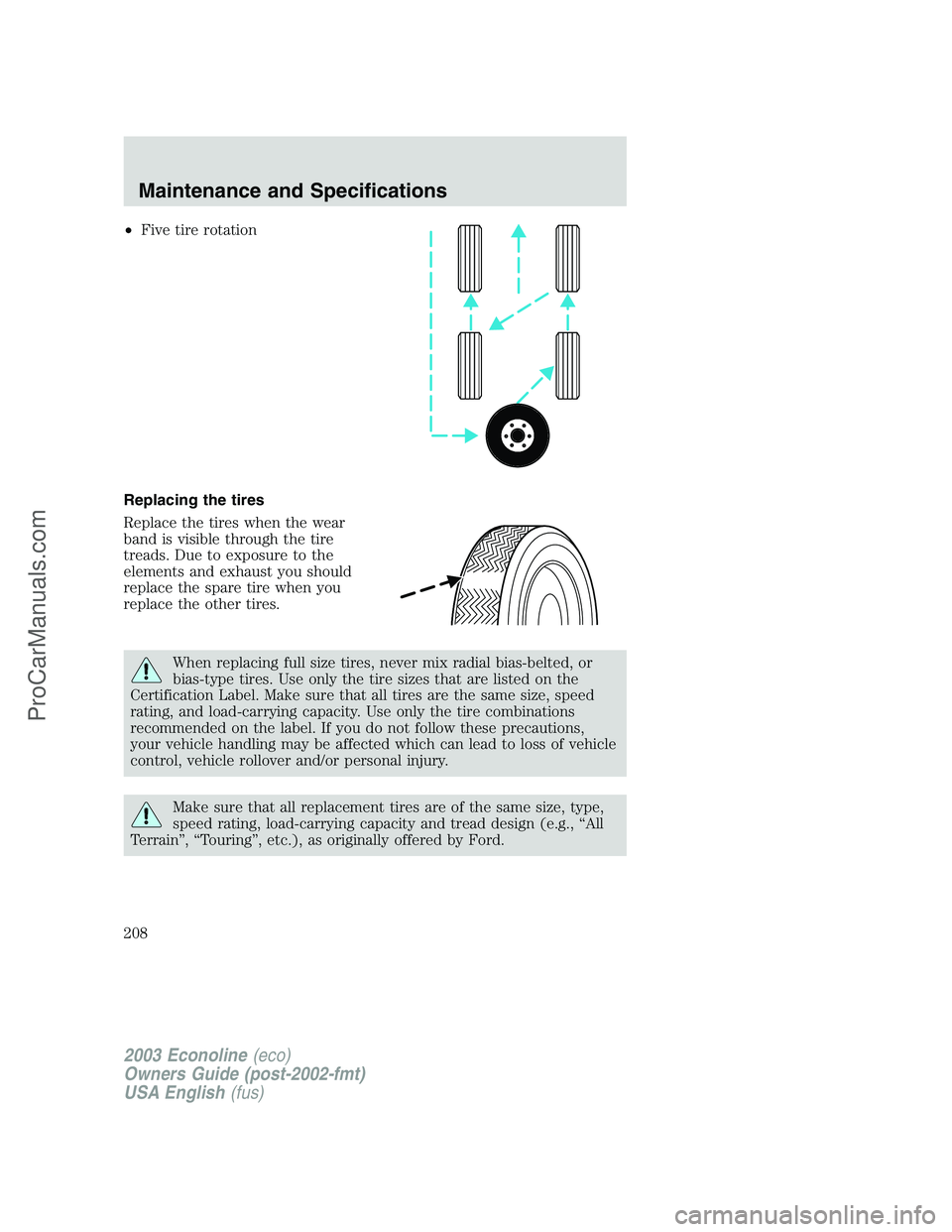
•Five tire rotation
Replacing the tires
Replace the tires when the wear
band is visible through the tire
treads. Due to exposure to the
elements and exhaust you should
replace the spare tire when you
replace the other tires.
When replacing full size tires, never mix radial bias-belted, or
bias-type tires. Use only the tire sizes that are listed on the
Certification Label. Make sure that all tires are the same size, speed
rating, and load-carrying capacity. Use only the tire combinations
recommended on the label. If you do not follow these precautions,
your vehicle handling may be affected which can lead to loss of vehicle
control, vehicle rollover and/or personal injury.
Make sure that all replacement tires are of the same size, type,
speed rating, load-carrying capacity and tread design (e.g.,“All
Terrain”,“Touring”, etc.), as originally offered by Ford.
2003 Econoline(eco)
Owners Guide (post-2002-fmt)
USA English(fus)
Maintenance and Specifications
208
ProCarManuals.com
Page 227 of 232
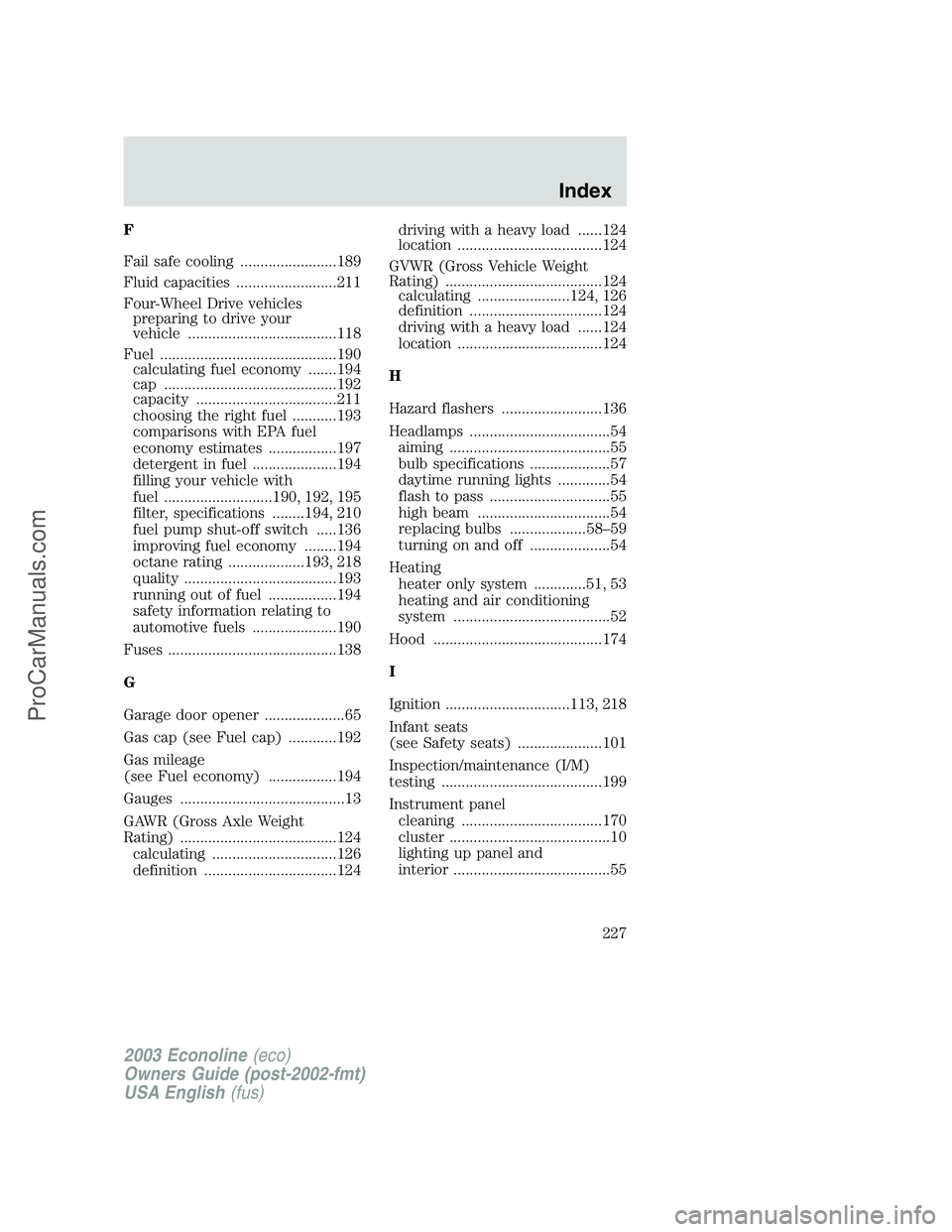
F
Fail safe cooling ........................189
Fluid capacities .........................211
Four-Wheel Drive vehicles
preparing to drive your
vehicle .....................................118
Fuel ............................................190
calculating fuel economy .......194
cap ...........................................192
capacity ...................................211
choosing the right fuel ...........193
comparisons with EPA fuel
economy estimates .................197
detergent in fuel .....................194
filling your vehicle with
fuel ...........................190, 192, 195
filter, specifications ........194, 210
fuel pump shut-off switch .....136
improving fuel economy ........194
octane rating ...................193, 218
quality ......................................193
running out of fuel .................194
safety information relating to
automotive fuels .....................190
Fuses ..........................................138
G
Garage door opener ....................65
Gas cap (see Fuel cap) ............192
Gas mileage
(see Fuel economy) .................194
Gauges .........................................13
GAWR (Gross Axle Weight
Rating) .......................................124
calculating ...............................126
definition .................................124driving with a heavy load ......124
location ....................................124
GVWR (Gross Vehicle Weight
Rating) .......................................124
calculating .......................124, 126
definition .................................124
driving with a heavy load ......124
location ....................................124
H
Hazard flashers .........................136
Headlamps ...................................54
aiming ........................................55
bulb specifications ....................57
daytime running lights .............54
flash to pass ..............................55
high beam .................................54
replacing bulbs ...................58–59
turning on and off ....................54
Heating
heater only system .............51, 53
heating and air conditioning
system .......................................52
Hood ..........................................174
I
Ignition ...............................113, 218
Infant seats
(see Safety seats) .....................101
Inspection/maintenance (I/M)
testing ........................................199
Instrument panel
cleaning ...................................170
cluster ........................................10
lighting up panel and
interior .......................................55
2003 Econoline(eco)
Owners Guide (post-2002-fmt)
USA English(fus)
Index
227
ProCarManuals.com
Page 228 of 232
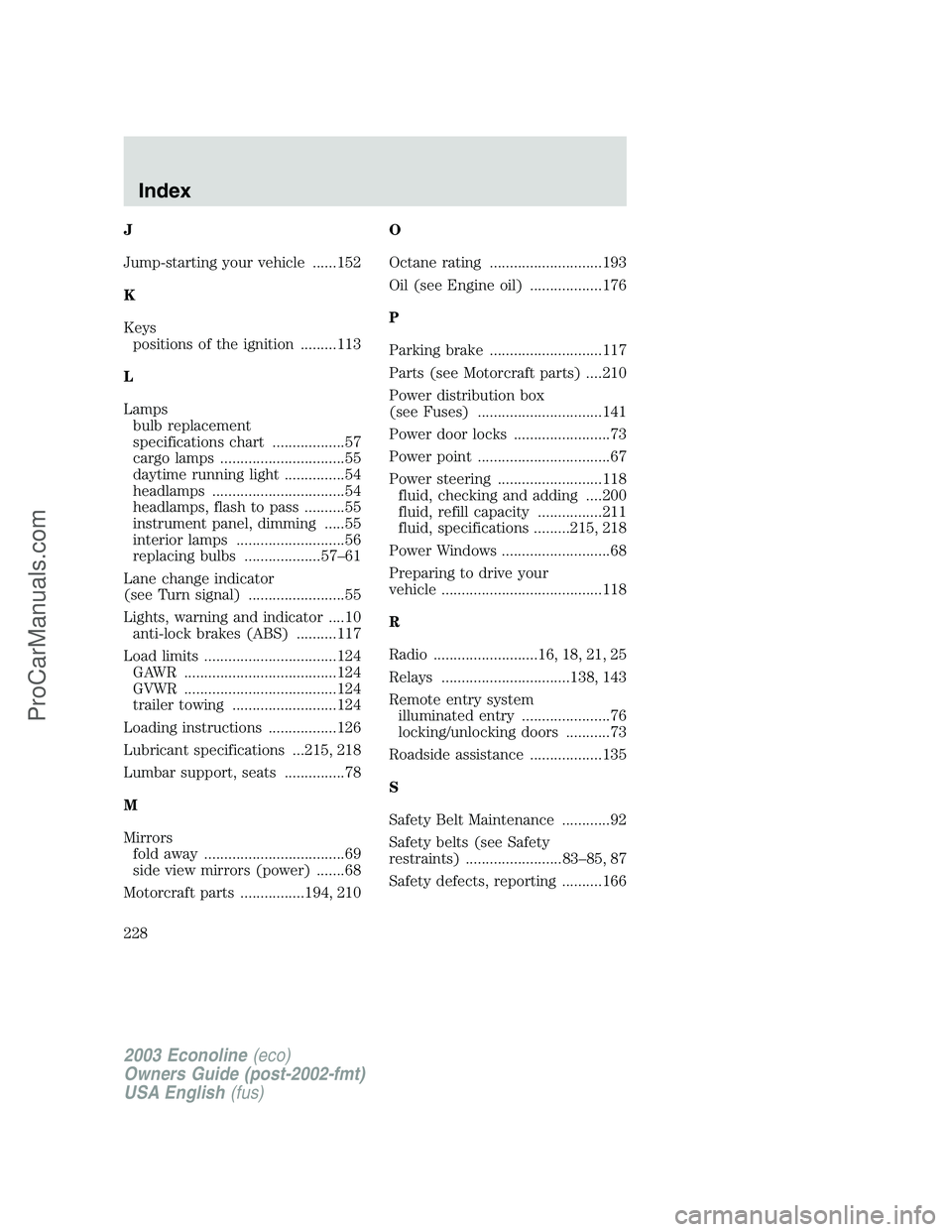
J
Jump-starting your vehicle ......152
K
Keys
positions of the ignition .........113
L
Lamps
bulb replacement
specifications chart ..................57
cargo lamps ...............................55
daytime running light ...............54
headlamps .................................54
headlamps, flash to pass ..........55
instrument panel, dimming .....55
interior lamps ...........................56
replacing bulbs ...................57–61
Lane change indicator
(see Turn signal) ........................55
Lights, warning and indicator ....10
anti-lock brakes (ABS) ..........117
Load limits .................................124
GAWR ......................................124
GVWR ......................................124
trailer towing ..........................124
Loading instructions .................126
Lubricant specifications ...215, 218
Lumbar support, seats ...............78
M
Mirrors
fold away ...................................69
side view mirrors (power) .......68
Motorcraft parts ................194, 210O
Octane rating ............................193
Oil (see Engine oil) ..................176
P
Parking brake ............................117
Parts (see Motorcraft parts) ....210
Power distribution box
(see Fuses) ...............................141
Power door locks ........................73
Power point .................................67
Power steering ..........................118
fluid, checking and adding ....200
fluid, refill capacity ................211
fluid, specifications .........215, 218
Power Windows ...........................68
Preparing to drive your
vehicle ........................................118
R
Radio ..........................16, 18, 21, 25
Relays ................................138, 143
Remote entry system
illuminated entry ......................76
locking/unlocking doors ...........73
Roadside assistance ..................135
S
Safety Belt Maintenance ............92
Safety belts (see Safety
restraints) ........................83–85, 87
Safety defects, reporting ..........166
2003 Econoline(eco)
Owners Guide (post-2002-fmt)
USA English(fus)
Index
228
ProCarManuals.com